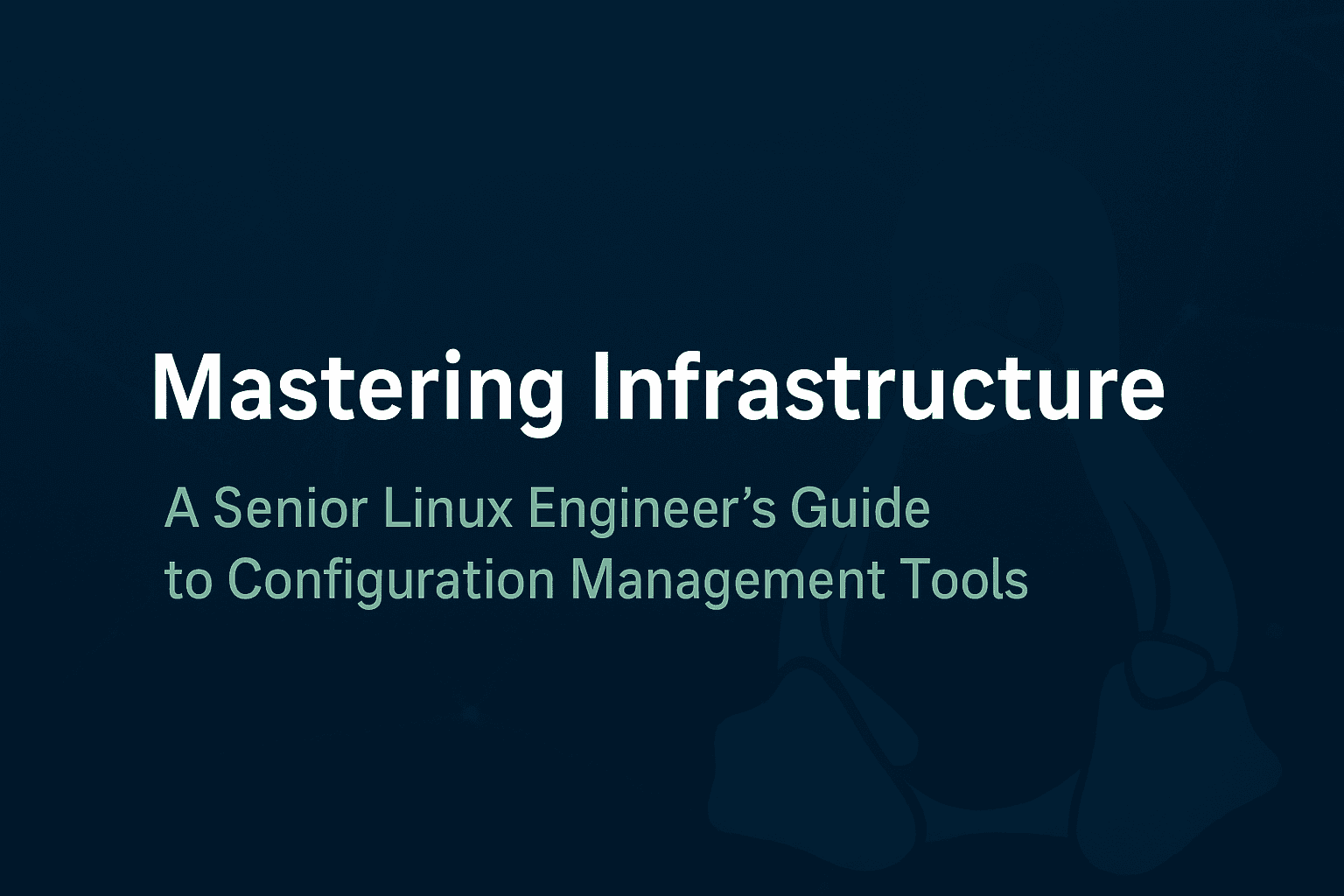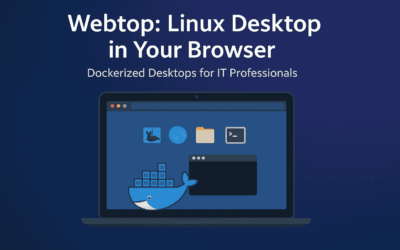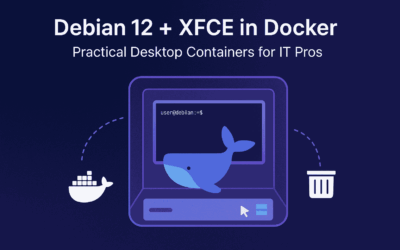Introduction
As IT Professionals, we live in a world where infrastructure is constantly evolving, and the sheer scale of managing servers, applications, and services can quickly become overwhelming. Manual configuration is not only prone to errors but also a colossal time sink. This is where Configuration Management (CM) tools become indispensable. They are the backbone of modern, scalable, and reliable IT operations, allowing us to define, deploy, and maintain the desired state of our systems with precision and automation.
In this blog post, we’ll dive into five of the most popular CM tools, exploring their core concepts, comparing their approaches, and understanding why each has earned its place in the engineer’s toolkit.
What is Configuration Management (CM)?
At its core, Configuration Management is the process of consistently managing and tracking the state of your system configurations. Think of it as version control for your infrastructure. Instead of manually configuring each server, you define your desired state in code. CM tools then take this “infrastructure as code” and ensure all your systems conform to it, automatically correcting any deviations (known as “configuration drift”). This leads to:
- Consistency: Every server, every environment, configured identically.
- Reliability: Reduced human error and predictable system behavior.
- Scalability: Easily manage hundreds or thousands of servers.
- Speed: Rapid deployment and recovery.
- Documentation: Your infrastructure is documented in an executable form.
Now, let’s explore the champions of this domain.
The Big Five: Popular CM Tools
1. Ansible
Ansible is renowned for its elegant simplicity and agentless architecture. Written in Python, it uses SSH to connect to remote hosts and execute tasks, making setup incredibly straightforward. Configurations are defined in human-readable YAML playbooks, which describe a desired state or a series of steps to achieve it. Its ease of use makes it a favorite for quick deployments and continuous delivery pipelines.
2. Puppet
Puppet is a mature, model-driven configuration management tool that operates on a master-agent architecture. Agents installed on client nodes periodically check in with a central Puppet master. The master compiles a “catalog” for each agent based on its manifest files (written in Puppet’s declarative DSL or Ruby), and the agent then applies these configurations to achieve the desired state. Puppet enforces state persistently, correcting drift automatically.
3. Chef
Chef also follows a master-agent model but distinguishes itself with a strong emphasis on code-driven infrastructure. Configurations are defined in “cookbooks” and “recipes” using a Ruby-based Domain Specific Language (DSL). This approach gives engineers immense flexibility and power, allowing for complex logic and integration with existing codebases. Chef is often favored by teams with strong development practices and a need for highly customizable automation.
4. SaltStack (Salt)
SaltStack is known for its incredible speed and scalability, making it ideal for managing very large infrastructures. It uses a master-minion architecture with a robust, event-driven communication bus. Salt excels at high-performance remote execution, allowing commands to be run across thousands of machines simultaneously. Configurations are typically defined in YAML state files (SLS files) and can be applied with a “push” or “pull” approach.
5. CFEngine
One of the original configuration management tools, CFEngine is built for efficiency and robustness. Written in C, it boasts a tiny memory footprint and exceptional performance, making it highly scalable for massive deployments. CFEngine focuses on a declarative, desired-state approach, ensuring systems are always converging towards their specified configuration. It operates with a light agent on each machine, emphasizing autonomy and self-healing.
Pushing vs. Pulling: How CM Tools Deliver Configurations
The method by which a configuration management tool applies changes to managed nodes is a fundamental differentiator:
- Push-Based (Orchestration): In a push model, the central CM server (or controller) actively initiates connections to the target nodes and “pushes” configurations and commands to them. This approach is often favored for its immediacy and control, as changes can be deployed on demand.
- Examples: Ansible primarily uses a push model. SaltStack can operate in a push model for remote execution.
- Pull-Based (Convergence): In a pull model, agents on the managed nodes periodically connect to the central CM server to “pull” their latest configurations. The agent then applies these configurations locally. This model is excellent for maintaining a desired state over time and automatically correcting configuration drift.
- Examples: Puppet, Chef, CFEngine, and SaltStack (for state application) primarily use a pull model.
Agents and Agentless: The Deployment Footprint
Another key distinction lies in whether the tool requires special software (an “agent”) to be installed on each managed node:
- Agent-Based: These tools require a lightweight client or agent to be installed and running on every machine they manage. The agent typically handles communication with the central server, executes commands, and reports back on the system’s state. This provides continuous monitoring and state enforcement.
- Examples: Puppet, Chef, SaltStack, CFEngine.
- Agentless: These tools do not require any special software to be installed on the managed nodes. They typically leverage existing protocols like SSH (for Linux/Unix) or WinRM (for Windows) to communicate and execute commands remotely. This simplifies initial setup and reduces overhead on target systems.
- Examples: Ansible.
Persistence: Maintaining the Desired State
A critical aspect of configuration management is ensuring that the desired state isn’t just achieved once, but persists over time. All the tools mentioned here are designed to enforce persistence, meaning they will detect and correct configuration drift.
- How it works: Agents (in agent-based systems) or regular runs (in agentless systems like Ansible’s scheduled playbooks) periodically check the current state of the system against the defined desired state. If a discrepancy is found, the tool automatically takes action to bring the system back into compliance.
- Why it matters: Without persistence, your systems would eventually drift away from their intended configurations, leading to inconsistencies, security vulnerabilities, and operational headaches. CM tools automate the self-healing of your infrastructure.
Final Thoughts
Choosing the right configuration management tool isn’t a one-size-fits-all decision. As IT Professionals, your choice will depend on several factors:
- Team Skillset: Does your team have strong Ruby or Python skills?
- Infrastructure Scale: Are you managing dozens, hundreds, or thousands of nodes?
- Existing Toolchain: How well does it integrate with your current CI/CD pipelines and monitoring tools?
- Complexity of Configurations: Do you need highly flexible, programmatic control or simple, declarative states?
- Speed Requirements: Is rapid ad-hoc execution a priority?
Ansible offers unmatched simplicity for quick deployments and orchestration. Puppet and Chef provide robust, enterprise-grade state enforcement with powerful declarative and programmatic capabilities, respectively. SaltStack shines with its incredible speed and scalability for large, dynamic environments, while CFEngine delivers unparalleled efficiency and self-healing for critical infrastructure.
Embracing configuration management is not just about automating tasks; it’s about shifting your mindset towards a more reliable, consistent, and scalable infrastructure. Invest time in understanding these tools, and you’ll empower yourself and your team to build and maintain robust systems with confidence.




